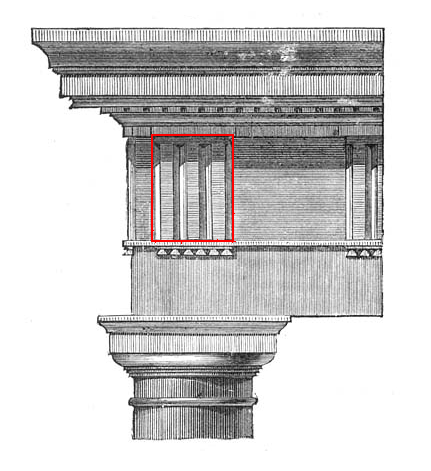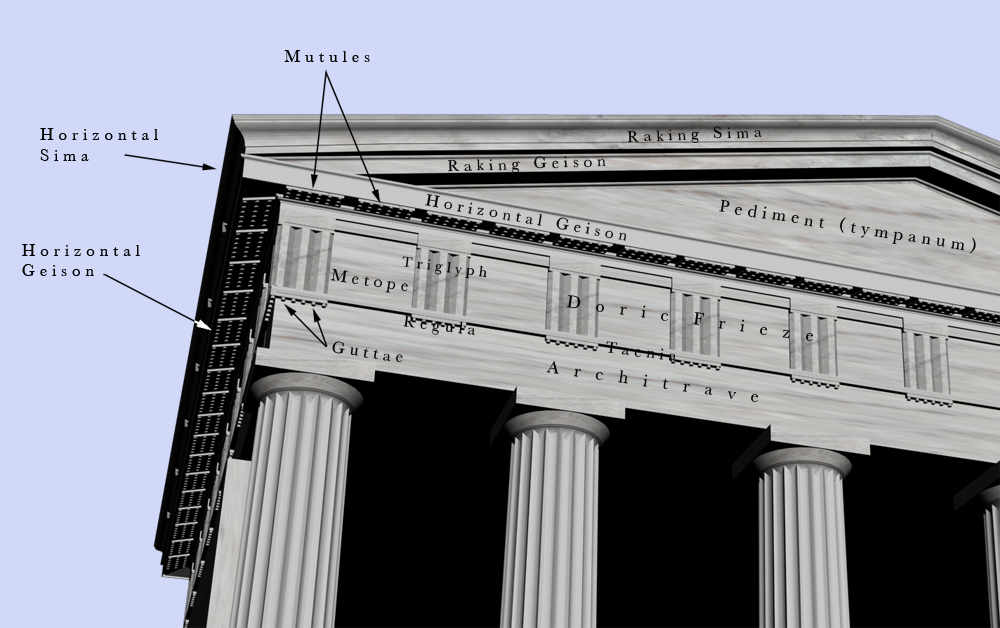|
Triglyph
Triglyph is an architectural term for the vertically channeled tablets of the Doric frieze in classical architecture, so called because of the angular channels in them. The rectangular recessed spaces between the triglyphs on a Doric frieze are called metopes. The raised spaces between the channels themselves (within a triglyph) are called ''femur'' in Latin or ''meros'' in Greek. In the strict tradition of classical architecture, a set of guttae, the six triangular "pegs" below, always go with a triglyph above (and vice versa), and the pair of features are only found in entablatures of buildings using the Doric order. The absence of the pair effectively converts a building from being in the Doric order to being in the Tuscan order. The triglyph is largely thought to be a tectonic and skeuomorphic representation in stone of the wooden beam ends of the typical primitive hut, as described by Vitruvius and Renaissance writers. The wooden beams were notched in three separate p ... [...More Info...] [...Related Items...] OR: [Wikipedia] [Google] [Baidu] |
Doric Order
The Doric order is one of the three orders of ancient Greek and later Roman architecture; the other two canonical orders were the Ionic and the Corinthian. The Doric is most easily recognized by the simple circular capitals at the top of the columns. Originating in the western Doric region of Greece, it is the earliest and, in its essence, the simplest of the orders, though still with complex details in the entablature above. The Greek Doric column was fluted, and had no base, dropping straight into the stylobate or platform on which the temple or other building stood. The capital was a simple circular form, with some mouldings, under a square cushion that is very wide in early versions, but later more restrained. Above a plain architrave, the complexity comes in the frieze, where the two features originally unique to the Doric, the triglyph and gutta, are skeuomorphic memories of the beams and retaining pegs of the wooden constructions that preceded stone Doric tem ... [...More Info...] [...Related Items...] OR: [Wikipedia] [Google] [Baidu] |
Metope (architecture)
A metope (; ) is a rectangular architectural element of the Doric order, filling the space between triglyphs in a frieze , a decorative band above an architrave. In earlier wooden buildings the spaces between triglyphs were first open, and later the free spaces in between triglyphs were closed with metopes; however, metopes are not load-bearing part of a building. Earlier metopes are plain, but later metopes were painted or ornamented with reliefs. The painting on most metopes has been lost, but sufficient traces remain to allow a close idea of their original appearance. In terms of structure, metopes were made out of clay or stone. A stone metope may be carved from a single block with a triglyph (or triglyphs), or they may be cut separately and slide into slots in the triglyph blocks as at the Temple of Aphaea. Sometimes the metopes and friezes were cut from different stone, so as to provide color contrast. Although they tend to be close to square in shape, some metopes are ... [...More Info...] [...Related Items...] OR: [Wikipedia] [Google] [Baidu] |
Ancient Greek Architecture
Ancient Greek architecture came from the Greeks, or Hellenes, whose Ancient Greece, culture flourished on the Greek mainland, the Peloponnese, the Aegean Islands, and in colonies in Asia Minor, Anatolia and Italy for a period from about 900 BC until the 1st century AD, with the earliest remaining architectural works dating from around 600 BC. Ancient Greek architecture is best known for its Ancient Greek temple, temples, many of which are found throughout the region, with the Parthenon regarded, now as in ancient times, as the prime example. Most remains are very incomplete ruins, but a number survive substantially intact, mostly outside modern Greece. The second important type of building that survives all over the Hellenic world is the Theatre of Ancient Greece#Characteristics of the buildings, open-air theatre, with the earliest dating from around 525–480 BC. Other architectural forms that are still in evidence are the processional gateway (''propylon''), the public square ... [...More Info...] [...Related Items...] OR: [Wikipedia] [Google] [Baidu] |
Gutta
A gutta (Latin pl. guttae, "drops") is a small water-repelling, cone-shaped projection used near the top of the architrave of the Doric order in classical architecture. At the top of the architrave blocks, a row of six ''guttae'' below the narrow projection of the taenia (fillet) formed an element called a regula. A ''regula'' was aligned under each triglyph of the Doric frieze. In addition, the underside of the projecting geison above the frieze had rectangular protrusions termed '' mutules'' that each had three rows of six ''guttae''. These mutules were aligned above each triglyph and each metope. It is thought that the guttae were a skeuomorphic representation of the pegs used in the construction of the wooden structures that preceded the familiar Greek architecture in stone. However, they have some functionality, as water drips over the edges, away from the edge of the building. Outside the Doric In the strict tradition of classical architecture, a set of guttae alwa ... [...More Info...] [...Related Items...] OR: [Wikipedia] [Google] [Baidu] |
Temple Of Aphaea
The Temple of Aphaia () is an Ancient Greek temple located within a sanctuary complex dedicated to the goddess Aphaia on the island of Aegina, which lies in the Saronic Gulf. Formerly known as the Temple of Jupiter Panhellenius, the Doric temple is now recognized as having been dedicated to the mother-goddess Aphaia. It was a favourite of Neoclassical and Romantic artists such as J. M. W. Turner. It stands on a c. 160 m peak on the eastern side of the island approximately 13 km east by road from the main port. Aphaia (Greek ) was a Greek goddess who was worshipped exclusively at this sanctuary. The extant temple of was built over the remains of an earlier temple of , which was destroyed by fire . Elements of this older temple were buried in the infill for the larger, flat terrace of the later temple, and are thus well preserved. Abundant traces of paint remain on many of these buried fragments. There may have been another temple in the 7th century BC, also ... [...More Info...] [...Related Items...] OR: [Wikipedia] [Google] [Baidu] |
Entablature
An entablature (; nativization of Italian , from "in" and "table") is the superstructure of moldings and bands which lies horizontally above columns, resting on their capitals. Entablatures are major elements of classical architecture, and are commonly divided into the architrave (the supporting member immediately above; equivalent to the lintel in post and lintel construction), the frieze (an unmolded strip that may or may not be ornamented), and the cornice (the projecting member below the pediment). The Greek and Roman temples are believed to be based on wooden structures, the design transition from wooden to stone structures being called petrification. Overview The structure of an entablature varies with the orders of architecture. In each order, the proportions of the subdivisions (architrave, frieze, cornice) are defined by the proportions of the column. In Roman and Renaissance interpretations, it is usually approximately a quarter of the height of the column. Va ... [...More Info...] [...Related Items...] OR: [Wikipedia] [Google] [Baidu] |
Foce Del Sele
The Heraion at Foce del Sele (English "Heraion at the mouth of the Sele (river), River Sele") is an archaeological site consisting of an Ancient Greek sanctuary complex dedicated to the goddess Hera in what was Magna Graecia. When built, the complex was located at the mouth of the Sele, approximately north of the Greek city of Paestum, Poseidonia that was famous for its three standing Greek temples. Due to the deposition of alluvial sediment by the river, the site now is approximately from the modern coast. The site is in the modern Italian comune of Capaccio-Paestum, some south of Salerno. Construction at the complex is dated from the sixth to at least the third centuries BC. The sanctuary included a Greek temple and other buildings. It was located in the countryside rather than in an urban development and may have included buildings to accommodate pilgrims. During the Middle Ages most of the stones were scavanged for use elsewhere as building materials or for other ... [...More Info...] [...Related Items...] OR: [Wikipedia] [Google] [Baidu] |
Tuscan Order
The Tuscan order (Latin ''Ordo Tuscanicus'' or ''Ordo Tuscanus'', with the meaning of Etruscan order) is one of the two classical orders developed by the Romans, the other being the composite order. It is influenced by the Doric order, but with un- fluted columns and a simpler entablature with no triglyphs or guttae. While relatively simple columns with round capitals had been part of the vernacular architecture of Italy and much of Europe since at least Etruscan architecture, the Romans did not consider this style to be a distinct architectural order (for example, the Roman architect Vitruvius did not include it alongside his descriptions of the Greek Doric, Ionic, and Corinthian orders). Its classification as a separate formal order is first mentioned in Isidore of Seville's 6th-century '' Etymologiae'' and refined during the Italian Renaissance. Sebastiano Serlio described five orders including a "Tuscan order", "the solidest and least ornate", in his fourth book of ... [...More Info...] [...Related Items...] OR: [Wikipedia] [Google] [Baidu] |
Skeuomorph
A skeuomorph (also spelled skiamorph, ) is a derivative object that retains ornamental design cues (attributes) from structures that were necessary in the original. Skeuomorphs are typically used to make something new feel familiar in an effort to speed understanding and acclimation. They employ elements that, while essential to the original object, serve no pragmatic purpose in the new system, except for identification. Examples include pottery embellished with imitation rivets reminiscent of similar pots made of metal and a software calendar that imitates the appearance of binding on a paper desk calendar. Definition and purpose The term ''skeuomorph'' is compounded from the Greek ''skeuos'' (σκεῦος), meaning "container or tool", and ''morphḗ'' (μορφή), meaning "shape". It has been applied to material objects since 1890. With the advent of graphical computer systems in the 1980s, skeuomorph is used to characterize the many "old fashioned" icons utilized in graphi ... [...More Info...] [...Related Items...] OR: [Wikipedia] [Google] [Baidu] |
Ionic Order
The Ionic order is one of the three canonic classical order, orders of classical architecture, the other two being the Doric order, Doric and the Corinthian order, Corinthian. There are two lesser orders: the Tuscan order, Tuscan (a plainer Doric), and the rich variant of Corinthian called the composite order. Of the three classical canonic orders, the Corinthian order has the narrowest columns, followed by the Ionic order, with the Doric order having the widest columns. The Ionic capital is characterized by the use of volutes. Ionic columns normally stand on a base which separates the shaft of the column from the stylobate or platform while the cap is usually enriched with egg-and-dart. The ancient architect and architectural historian Vitruvius associates the Ionic with feminine proportions (the Doric representing the masculine). Description Capital The major features of the Ionic order are the volutes of its capital (architecture), capital, which have been the subject of mu ... [...More Info...] [...Related Items...] OR: [Wikipedia] [Google] [Baidu] |
Temple Of Hephaestus
The Temple of Hephaestus or Hephaisteion (also "Hephesteum" or "Hephaesteum"; , , and formerly called in error the Theseion or "Theseum"; , ), is a well-preserved Greek temple dedicated to Hephaestus; it remains standing largely intact today. It is a Doric peripteral temple, and is located at the north-west side of the Agora of Athens, on top of the Agoraios Kolonos hill. From the 7th century until 1834, it served as the Greek Orthodox church of Saint George Akamates. The building's condition has been maintained due to its history of varied use. Name Hephaestus is the patron god of metal working, craftsmanship, and fire. There were numerous potters' workshops and metal-working shops in the vicinity of the temple, as befits the temple's honoree. Archaeological evidence suggests that there was no earlier building on the site except for a small sanctuary that was burned during the Second Persian invasion of Greece in 480 BCE. The name ''Theseion'' or Temple of Theseus was attri ... [...More Info...] [...Related Items...] OR: [Wikipedia] [Google] [Baidu] |
Fascia (architecture)
Fascia () is an architectural term for a vertical frieze or band under a roof edge, or which forms the outer surface of a cornice, visible to an observer. Typically consisting of a wooden board, unplasticized PVC (uPVC), or non-corrosive sheet metal, many of the non-domestic fascias made of stone form an ornately carved or pieced together cornice, in which case the term fascia is rarely used. The word fascia derives from Latin ''fascia'' meaning "band, bandage, ribbon, swathe". The term is also used, although less commonly, for other such band-like surfaces like a wide, flat trim strip around a doorway, different and separate from the wall surface. The horizontal "fascia board" which caps the end of rafters outside a building may be used to hold the rain gutter. The finished surface below the fascia and rafters is called the soffit or eave. In classical architecture, the fascia is the plain, wide band (or bands) that make up the architrave section of the entablature, dire ... [...More Info...] [...Related Items...] OR: [Wikipedia] [Google] [Baidu] |






